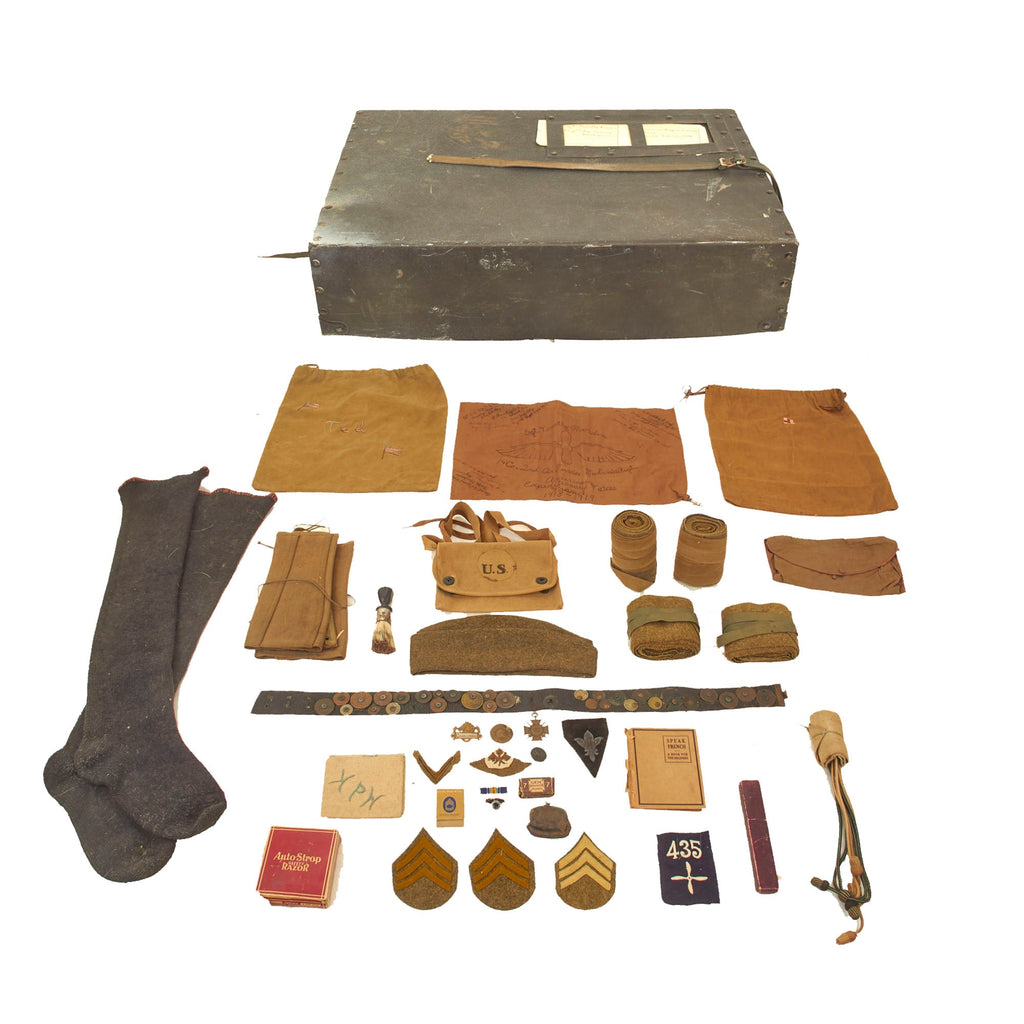Item Description
Original Items: Only One Grouping Available. The United States Army Air Service (USAAS) was the aerial warfare service component of the United States Army between 1918 and 1926 and a forerunner of the United States Air Force. It was established as an independent but temporary branch of the U.S. War Department during World War I by two executive orders of President Woodrow Wilson: on May 24, 1918, replacing the Aviation Section, Signal Corps as the nation's air force; and March 19, 1919, establishing a military Director of Air Service to control all aviation activities. Its life was extended for another year in July 1919, during which time Congress passed the legislation necessary to make it a permanent establishment. The National Defense Act of 1920 assigned the Air Service the status of "combatant arm of the line" of the United States Army with a major general in command.
The “trunk grouping” belonged to Sergeant Timothy Riordan, a mechanic with the 2nd Army Air Service, an element established towards the end of the war. It comes in a very nice named and labeled case measuring 21" x 13" x 5". The grouping consists mainly of uniform items such as an overseas cap, leg protectors, chevrons, razors, French translation book, a red cross bag and a few pouches. There are a few items that stood out amongst the rest, one of which being a “hate belt”, but not like you are used to seeing. This leather belt is a German DRGM black leather belt without buckles and has 28 coins affixed to it via brass rivets. The coins vary in country and may have been souvenirs from countries traveled to or traded for.
The second item that stood out is a rather unique one. It is a personalized “Khaki Komfort Kushion” , an inflatable pillow. In the field or the trenches, soldiers were separated from the comfort of bedding. To help soldiers feel a bit more comfortable as they slept, companies began producing portable, inflatable pillows made out of rubber. They were compact, being stored in a rubberized pouch when not in use. To inflate the pillow, the soldier would remove the pillow from the pouch and blow into a valve stem to inflate.
This pillow appears to serve as some sort of timeline of service giving the names, dates and locations of places traveled to including what ships he was on. There are also other names of soldiers present and their mailing addresses, most likely done so to keep in contact after the war. The writing is still nice and dark making it easy to read the script that is present.
This is a wonderful and rather unique grouping, a perfect candidate for a research project!
In France, the Air Service of the American Expeditionary Force, a separate entity under commanding General John J. Pershing that conducted the combat operations of U.S. military aviation, began field service in the spring of 1918. By the end of the war, the Air Service used 45 squadrons to cover 137 kilometers (85 miles) of front from Pont-à-Mousson to Sedan. 71 pursuit pilots were credited with shooting down five or more German aircraft while in American service. Overall the Air Service destroyed 756 enemy aircraft and 76 balloons in combat. 17 balloon companies also operated at the front, making 1,642 combat ascensions. 289 airplanes and 48 balloons were lost in battle.
The Air Service was the first form of the air force to have an independent organizational structure and identity. Although officers concurrently held rank in various branches, after May 1918 their branch designation in official correspondence while on aviation assignment changed from "ASSC" (Aviation Section, Signal Corps) to "AS, USA" (Air Service, United States Army). After July 1, 1920, its personnel became members of the Air Service branch, receiving new commissions. During the war its responsibilities and functions were split between two coordinate agencies, the Division of Military Aeronautics (DMA) and the Bureau of Aircraft Production (BAP), each reporting directly to the Secretary of War, creating a dual authority over military aviation that caused unity of command difficulties.
The seven-year history of the post-war Air Service was marked by a prolonged debate between adherents of airpower and the supporters of the traditional military services about the value of an independent Air Force. Airmen such as Brig. Gen. Billy Mitchell supported the independent air concept. The Army's senior leadership from World War I, the United States Navy, and the majority of the nation's political leadership favored integration of all military aviation into the Army and Navy. Aided by a wave of pacifism following the war that drastically cut military budgets, opponents of an independent air force prevailed. The Air Service was renamed the Army Air Corps in 1926 as a compromise in the continuing struggle.
- This product is available for international shipping.
- Eligible for all payments - Visa, Mastercard, Discover, AMEX, Paypal & Sezzle
















































